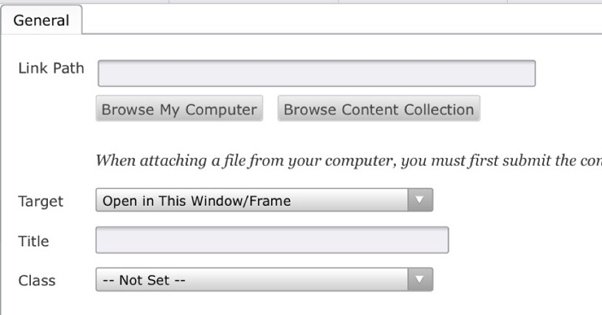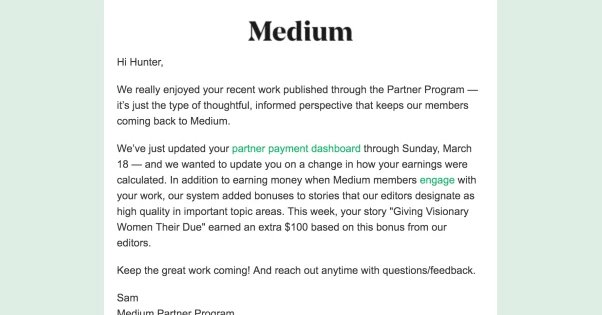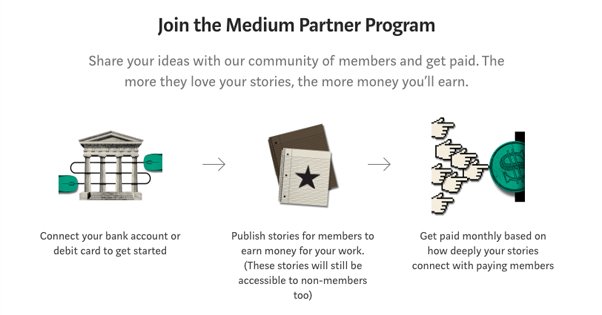The Ultimate Guide to Earning Money from Medium.com Articles
Published by Kenny Novak • Monetization • Posted April 29, 2019 ContentPowered.com
ContentPowered.com
Medium is a fantastic platform for a lot of bloggers. It lacks some of the benefits of having your own domain, controlling your own hosting, and running your own version of WordPress, but it more than makes up for those with the audience and exposure it can bring to the table. On top of that, you can make some serious money from it.
How much money can you make? It’s easy enough to find posts about people making $1,000 a month, $2,000 a month, or more. One guy even made nearly $50K in affiliate payouts in one post. Now, not everyone is going to make that much money, and you’ll definitely get nowhere near that level when you’re first starting out, but the sky really can be the limit.
Strategies for Making Money
There are three different primary ways you can make money on Medium, though there are plenty of different techniques and paths you can take within each of those three.
The first option is to go with the traditional monetization for blogging: selling stuff on your website. You can use a Medium blog as your company blog, and frequently link to your own website for various purposes. Traffic referred to your site can end up on landing pages or in other parts of your sales funnel, where they can then go on to purchase your product or service, hire you for consulting, or whatever else it is you offer.
The second option is another traditional monetization route for blogs, and that’s the various sort of middle-man affiliate marketing you see pretty much everywhere. Write content recommending different products and services, and use affiliate links and dropshipping codes for selling through your posts. Depending on what you’re offering, how well you can sell it to an audience, and how high quality your content is, you can make a ton of money with this method.
The third option is to go with Medium’s standard monetization. That’s right: Medium allows you to monetize the views and engagement you get on their site. It’s a little tricky and has some unique quirks to it, but it exists and it can earn you a decent chunk of change each month.
Of course, at the end of the day, the best technique to use is “all of them.” Why limit yourself to just one of them, when you can take advantage of all three with the right setup? That’s why I’m going to talk about all three methods here today.
Oh, and to address a common question: Medium does not explicitly prohibit affiliate links or other forms of monetized outbound content. You can’t do something like embed Google Ads into a post, and you can’t publish sponsored content, but you can link to your own site and you can link to affiliate products. The rules:
- Third-party advertising and sponsorships are not allowed. You may not advertise or promote third-party products, services, or brands through Medium posts, publications, or letters. This includes images that indicate brand sponsorship in a post or letter, or as part of a publication name or logo.
- Images functioning as third-party ads are not allowed. Inline images or embeds that link out and function as banner ads for third-party brands are not allowed.
- You must disclose affiliate links or payment for a post. Affiliate links, such as link out to Amazon with your code, or any other link out where you will receive a commission or other value, are allowed in posts. But, you must disclose somewhere in the post that it includes affiliate links. If you have received payment, goods or services, or something else of value in exchange for writing a post, you must still disclose this fact in writing within your post.
Be sure to check the rules linked above if you’re reading this in 2020 or further in the future, to make sure Medium hasn’t changed the rules since I wrote this. If they have, let me know.
Monetizing Through Medium Itself
The first of the options I’m going to discuss is Medium’s built-in monetization program. Medium allows anyone to monetize their content, so long as they meet the very basic requirement of “being able to use Stripe.” So, I guess if you’ve been banned from Stripe specifically, you’ll be out of luck. That or if you’re in one of the countries Stripe doesn’t cover, which is actually quite a few. Sorry, Greenland, Russia, all of Africa, or the middle east. You’re not eligible.
The way the system works is pretty simple.
- You join Medium as an author. Anyone can do this; every account on Medium has the ability to publish content, there is no difference between a casual reader or an author account.
- You join the Medium Partner Program. I’ll discuss a bit more about what this means in a moment.
- You write a good piece of content. It doesn’t really matter what the content is about, so long as it’s high quality. It can be short or long, funny or serious, unbiased or opinionated; it doesn’t matter. All you have to do is make sure you abide by the rules Medium publishes. This does restrict your topics somewhat; you can’t publish anything inflammatory, hateful, or about cryptocurrency. The latter is just too full of spam and fraud, Medium doesn’t want to deal with it.
- On your published content, enable distribution and earnings. This allows your content to be monetized.
Normally, content won’t receive a lot of attention without some kind of promotion. You can circulate it on social media, link to it in other blogs, and generally promote it yourself, which can work. It can also be put in front of the Medium Curators, who are a team of users who, if they like your content enough, can add it to curated publications and topic lists, which is the equivalent of getting to the front page of Medium. You can read more about the curators and what they look for here.
Medium’s monetization is unique. Many other megablogs, like HubPages, run advertising on their blogs and give you a cut of what your content earns. This is notoriously fickle, low paying, and unlikely to earn you much money. Medium doesn’t run advertising, so you don’t have to contend with this scheme.
On Medium, some content is locked behind a paywall. Users can read any and all free content at any time, and they can read something like five paid posts per month before the paywall closes. You can pay for a pro-tier subscription, which gives you access to all paid content, for $5 per month.
This is relevant, because this is how your content earns money. When a paid reader reads your content, and when people “clap” for your content – the equivalent of an upvote or a like – you earn a bit of money. Specifically, you are given a portion of the paid user’s subscription fee. Their $5 is divided up between all of the posts they read that are monetized. It’s a strange system, but it seems to work. The exact amount you earn is based on several factors, ranging from read time to claps to volume.
Medium tallies up what your content earns on a weekly basis, updating your dashboard on Wednesdays with earnings up through the previous Sunday. They pay out your balance on the last Wednesday of each month.
As for how to maximize your earnings, well, that’s a topic for another time. You’ll want to start up a Medium blog, of course, and you’ll want to promote it for the greatest possible returns.
Using Medium to Advertise Yourself
Using Medium to promote your own company and your own products and services is probably one of the most common ways people use it. No promotional post is going to hit the big time, and no Medium curator is going to want to push your promotional post to the front page, but that doesn’t mean you’re going to lack an audience.
The key here, in my mind, is to provide plenty of high quality content on your own website as well. While it doesn’t seem like maintaining two blogs is a good idea, hear me out.
For your home site, write one flagship post per month. These should be huge, 10K word monstrosities that cover a topic in great detail, full of citations, great information, actionable tips, and unique data points. It’s not too terribly difficult to produce this level of content on a monthly basis.
Use your Medium blog as your weekly standard blog, like what you’re reading here and now. Write high quality blog posts, but don’t go into really deep dives. The trick, of course, is to link your Medium posts back to your mega-posts on your own site.
Your own site, then, should be sending the people who land on it to deeper parts of your sales funnel. Use all the tricks in the book; a sidebar scroller, a slide-in, an exit-intent window, a Hello Bar, whatever it takes. Test different tools and combinations of tools to see what you can do to get people from your posts to your landing pages, or from your posts directly to your product pages.
Obviously, there’s a lot of variety to this strategy. I leave it to you to do the testing and the optimization, just as you would with any marketing strategy.
Using Medium to Advertise Affiliates
This is where things get a little tricky. Medium allows affiliate links, but you absolutely need disclosure for them, or you risk all sorts of penalties. I would be absolutely unsurprised if Medium forcibly removed your content if you don’t disclose affiliate links, and even more so, they could close your account.

The reason you need disclosure, by the way, is because of FTC rules. It’s not a policy set forth by the site, it’s a legal policy set forth by the government. Lack of disclosure risks Medium as a whole, and obviously they would rather shut you down than let you get them shut down.
Is it realistic that the FTC would shut down Medium over a few users with undisclosed affiliate links? Probably not. Would they be fined? Possibly. Would the backlash fall entirely on you if it happened? Almost certainly.
All that just means they want you to disclose when any links in your post are affiliate links. You can do that by adding a line like “this post includes affiliate links” at the front or at the end, or you can flag each link individually with (affiliate). The specific disclosure doesn’t really matter, so long as it’s there.
As for what you should promote, well, all of the usual rules for affiliate marketing come into play here. It doesn’t matter what you’re promoting, so much as how you’re promoting it.
In other words, your content still needs to be lengthy and high quality, and you need to have an objective look at the products or a real good reason why you’re sharing them. The guy up above with Uber and Lyft affiliates did a very detailed comparison between the two services, with “oh and here are some affiliate sign-up links if you want to give them a try.” It works because it was useful information aimed at getting people interested in the services.
Write high quality content, link to no more than a couple of affiliate links in each post, and make sure you’re genuinely recommending them or giving an objective view or review for them. The thinner and less useful your content, the less likely you are to get any exposure for it or earn any money from it.








